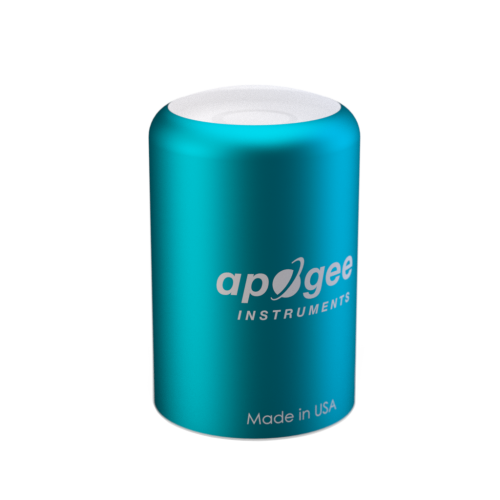
あらゆる光源下で、正確で安定した耐久性のあるPAR測定が可能






概要
CS310は、0~40mV出力のセルフパワー型アナログフルスペクトル光量子センサです。このセンサは、青色強化シリコンフォトダイオードとカスタムマイズされた光学フィルタを内蔵しており、アクリルディフューザ付きの陽極酸化アルミボディを含む、堅牢でセルフクリーニング可能なセンサハウジング設計となっています。典型的なアプリケーションは、屋外環境、温室、生育室での植物キャノピー上のPPFD測定や同じ環境での反射またはキャノピー下(透過)PPFD測定です。
続きを読む利点と特徴
- スペクトル範囲389~692nm(±5nm)のフルスペクトル光量子センサ
- 発光ダイオード(LED)を含むあらゆる光源下で正確な測定が可能
- ドーム型のアルマイト製ボディは、頑丈でセルフクリーニングが可能
- IP68規格のコネクタにより、湿気の多い過酷な環境でも安心
- センサヘッドは、船舶用316-Lステンレス製コネクタでケーブルから取り外し可能
- 工場出荷時の校正データがセンサに保存されているため、正確な測定のためにセンサ固有の校正係数不要
- 各センサは管理された条件下で慎重に校正され、NIST参照標準にトレーサブル
- 4年間のメーカー保証
イメージ







類似製品
詳細
参考資料
- Federer, C.A., and C.B. Tanner, 1966. Sensors for measuring light available for photosynthesis. Ecology 47:654-657.
- Ross, J., and M. Sulev, 2000. Sources of errors in measurements of PAR. Agricultural and Forest Meteorology 100:103-125.
- Federer, C.A., and C.B. Tanner, 1966. Sensors for measuring light available for photosynthesis. Ecology 47:654-657.
- Inada, K., 1976. Action spectra for photosynthesis in higher plants. Plant and Cell Physiology 17:355-365.
- McCree, K.J., 1972a. The action spectrum, absorptance and quantum yield of photosynthesis in crop plants. Agricultural Meteorology 9:191-216.
- McCree, K.J., 1972b. Test of current definitions of photosynthetically active radiation against leaf photosynthesis data. Agricultural Meteorology 10:443-453.
- Sager, J.C., W.O. Smith, J.L. Edwards, and K.L. Cyr, 1988. Photosynthetic efficiency and phytochrome photoequilibria determination using spectral data. Transactions of the ASAE 31:1882-1889.
スペクトル応答
'ウェブページの画像セクションにある平均分光感度特性のグラフを参照してください。このグラフは、6個のApogee SQ100およびCS310光量子センサの平均分光感度特性を示しています。分光感度特性の測定は、電気光源を取り付けたモノクロメータ内で、300~800 nmの波長範囲にわたって10 nm刻みで行われました。各光量子センサの測定スペクトルデータは、分光放射計で測定されたモノクロメータと電灯の組み合わせの測定スペクトル応答で正規化されます。
仕様
| センサー | 青色強化シリコンフォトダイオードとカスタム光学フィルター |
| 測定の説明 | 自然光と人工光の両方で光合成光量子束密度 (PPFD) を測定 |
| 電源 | 自己給電式 |
| 感度 | 0.01 mV/µmol m-2 s-1 |
| 校正係数 (感度の逆数) | 100.0 µmol m-2 s-1/mV |
| 校正の不確実性 | ±5% (1日の総放射線量) |
| 校正出力範囲 | 0 ~ 40 mV |
| 測定範囲 | 0 ~ 4000 µmol m-2 s-1 |
| 測定の再現性 | < 1% (最大4000 μmol m-2 s-1) |
| 長期ドリフト | < 2% /年 |
| 非直線性 | < 1% (最大4000 µmol m-2 s-1) |
| 応答時間 | < 1 ms |
| 視野 (FOV) | 180° |
| スペクトル範囲 | 389 ~ 692 nm ±5 nm (応答が最大値の50%を超える波長) |
| スペクトル選択性 | 412~682 nm ±5 nm の範囲で 10% 未満 |
| 方向(コサイン)応答 | ±5% (at 75° zenith angle) |
| 方位誤差 | < 0.5% (天頂角75°) |
| 傾斜誤差 | < 0.5% |
| 温度応答 | -0.11 ±0.04% / °C |
| 日計の不確実性 | < 5% |
| 検出器 | 青色強化シリコンフォトダイオード |
| ハウジング | アクリルディフューザー付きアルマイト加工アルミニウムボディ |
| IP 定格 | IP68 |
| 動作温度範囲 | -40° ~ +70°C |
| 動作環境 | 0 ~ 100% 相対湿度 |
| ケーブル |
5 m のシールド付きツイストペア線 追加ケーブルは 5 m 単位で入手可能。サントプレーン ラバー ジャケット (高い耐水性、高い UV 安定性、寒冷環境でも柔軟性)。ピグテール リード線 (材料や製造上の欠陥に対する) |
| 保証 | 4 年間 (材料および製造上の欠陥に対して) |
| 直径 | 2.4 cm (0.9 in.) |
| 高さ | 3.5 cm (1.4 in.) |
| 重量 | 100 g 5 m 5線 (3.53 16.4 リード線16.4フィート込み |
互換性
注意: 以下は代表的な互換性情報を示しています。互換性のある製品や互換性のない製品をすべて網羅したリストではありません。
Data Loggers
| 製品 | 互換性 | 注意 |
|---|---|---|
| CR1000 (リタイア) | ||
| CR1000X (リタイア) | ||
| CR300 (リタイア) | ||
| CR3000 (リタイア) | ||
| CR310 | ||
| CR350 | ||
| CR6 | ||
| CR800 (リタイア) | ||
| CR850 (リタイア) |
互換性に関する追加情報
取り付け
正確な測定を行うには、18356 水平調整器具を使用してセンサーを水平にする必要があります。この水平調整器具には、気泡レベルと 3 つの水平調整ネジが組み込まれています。18356 は、CM225 取り付けスタンドまたは 015ARM を使用してクロスアームに取り付けます。CS310 は、測定に悪影響を与える可能性のあるすべての障害物や反射面から離れた場所に取り付ける必要があります。
ドキュメント
カタログ
マニュアル
コンプライアンス
よくある質問
CS310に関するよくある質問の数: 3
すべて展開すべて折りたたむ
-
水平調整ベースは物理的な安定性を提供し、センサが適切に水平に保たれるようにします。ベースなしでセンサを使用することはお勧めしません。センサは付属のボルトでベースに取り付けられます。ただし、穴が開けられたユーザー提供のプレートを代わりに使用して、センサの取り付けボルトを取り付けることもできます。
-
Clear Sky Calculator (www.clearskycalculator.com) を使用すると、光量子センサの再較正の必要性を判断できます。このツールは、世界中のあらゆる場所で、1 日のどの時間でも、水平面に入射する PPFD を測定します。春と夏の太陽の正午近くで使用すると最も正確で、世界中のあらゆる気候と場所で、晴れて汚染されていない複数の日における精度は ±4% と推定されます。最高の精度を得るには、空が完全に晴れている必要があります。雲からの反射放射により、入射放射が Clear Sky Calculator で予測された値を超えて増加するためです。雲の側面と端からの反射により、PPFD の測定値は Clear Sky Calculator で予測された値を超える場合があります。この反射により、入射放射が増加します。高層雲の影響は、通常、晴天値を超えるスパイクとして現れ、晴天値を超える一定のオフセットとして現れるわけではありません。
再校正の必要性を判断するには、計算機に現場の状況を入力し、晴天時の PPFD 測定値と計算された PPFD 値を比較します。太陽の正午付近の複数日間にわたるセンサの PPFD 測定値が計算値と一貫して異なる場合 (6% 以上)、センサをクリーニングして再調整する必要があります。2 回目のテスト後も PPFD 測定値が異なる場合は、Campbell Scientific に連絡して RMA を取得し、センサを再校正してください。
ケーススタディ
概要 気候変動との戦いにおいて、大気中の温室効果ガス濃度の上昇という地球規模の課題に対処するための革新的な解決策が生まれています。英国生態学・水文学センター (UKCEH) は、アベリストウィス大学などと提携して、この研究の最前線に立っています。Campbell Scientific社の最先端の渦相関システムを使用して、UKCEH はさまざまな作物による CO2 吸収を監視するプロジェクトを先導しており、主に多用途のススキ (エレファント グラス) に焦点を当てています。 課題 大気中の温室効果ガス濃度の上昇という差し迫った問題に対処するには、その地球温暖化への影響を総合的に理解し、その影響を緩和する必要があります。課題は、エネルギー安全保障と農村経済を維持しながら、大気中の CO2 濃度の削減に積極的に貢献する持続可能な解決策を見つけることです。 解決策 UKCEH は、キャンベル サイエンティフィック社の高度な渦相関システムを導入し、作物による大気中の CO2......続きを読む
記事とプレスリリース
ニュースレター記事
Privacy Policy Update
We've updated our privacy policy. 詳細はこちら
Cookie Consent
Update your cookie preferences. クッキーの設定を更新する

